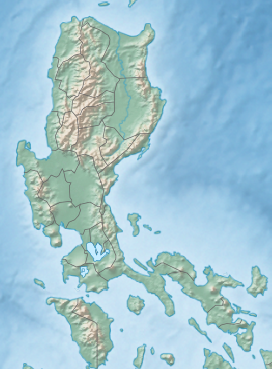Mount Data
| Mount Data | |
|---|---|
 | |
| Highest point | |
| Elevation | 2,310 m (7,580 ft)[1] |
| Prominence | 18 m (59 ft) |
| Coordinates | 16°53′0″N 120°50′48″E / 16.88333°N 120.84667°E |
| Geography | |
| Country | Philippines |
| Region | Cordillera Administrative Region |
| Province | |
| Parent range | Cordillera Central |
Mount Data is a mountain located in the Cordillera Central mountain range rising to a height of 2,310 metres (7,580 ft) in the north of Luzon Island, Philippines.[2] It is about 100 kilometres (62 mi) north of Baguio on the borders of the provinces of Benguet and Mountain Province along the Halsema Highway.[3][4] The mountain and surrounding area has been declared a national park since 1936. In 1940 the park was expanded to 5,513 hectares (13,620 acres).[5][1] The slopes of the mountain are covered with pine forests and mossy oak forests.[4]
The national park hosts five major rivers: the Chico, Ahin, Siffu, Abra, and Amburayan rivers. The Agno River also originates from Mount Data and flows through Benguet.[6] The reserve is also a watershed, which serves towns in Mountain Province, Buenget, and Ifugao.[7]
The mountain is the site of the Mount Data Peace Accord of 1986 between the government of the Philippines and the Cordillera People's Liberation Army.[8]
Fauna
[edit]Mount Data is formerly known for its great biological diversity and is a place that has long been in the attention of biologists. In 1895, the Englishman John Whitehead gathered a vast collection of mammals and birds from the mountain. This mammal collection was then donated to the British Museum. A research by zoologist Oldfield Thomas showed that many unknown species inhabit the area. Half a century later, a large collection of small mammals was collected by an expedition led by the Filipino biologist Dioscoro S. Rabor.[9] Some of these mammals are Carpomys melanurus (short-footed Luzon tree rat) and Carpomys phaeurus (white-bellied Luzon tree rat). In addition to several rare species of mammals, there are also some bird species like the Collocalia whiteheadi (Whitehead's swiftlet), which was only known then from a specimen that was caught during the expedition of John Whitehead on the mountain.[10]
Carpomys melanurus (greater dwarf cloud rat) was first found on Mount Data in 1896.[11]
See also
[edit]References
[edit]- ^ a b Cairns, Malcolm, ed. (2017). Shifting Cultivation Policies: Balancing Environmental and Social Sustainability. Oxfordshire: CABI. p. 720. ISBN 978-1-78639-179-7.
- ^ "Mount Data". Protected Planet. Archived from the original on April 22, 2018. Retrieved April 22, 2018.
- ^ Grele, Dominique; Jouve, Lily Yousry (2003). 100 Resorts in the Philippines: Places with a Heart (2nd ed.). Mandaluyong City: Encyclea. p. 77. ISBN 971-91719-7-9.
- ^ a b "Mt. Province Travel Information". Asia Travel. Archived from the original on May 7, 2001. Retrieved February 22, 2019.
- ^ Perera, Jayantha, ed. (2009). Land and Cultural Survival: The Communal Rights of Indigenous Peoples in Asia. Mandaluyong City: Asian Development Bank. p. 71. ISBN 978-971-561-801-4.
- ^ "Cordilleras Lose 500 Hectares of Forest Cover Yearly–Alvarez". Business Mirror. July 6, 2015. Archived from the original on January 23, 2022. Retrieved August 2, 2020.
- ^ Quitasol, Kimberlie (June 13, 2016). "DENR Rejects Mt. Data Downgrade from Protected Park". Inquirer.net. Archived from the original on December 2, 2020. Retrieved August 2, 2020.
- ^ De Mesa, Karl R. (September 20, 2011). "Cordillera Celebrates 25th Anniversary of Peace Accord". GMA News Online. Archived from the original on January 23, 2022. Retrieved August 2, 2020.
- ^ Heaney, Lawrence R.; Balete, Danilo S.; Sarmiento, Joel; Alviola, Phillip (July 4, 2006). "Losing Diversity and Courting Disaster: The Mammals of Mt. Data National Park". Haribon Foundation. Archived from the original on July 13, 2007. Retrieved June 13, 2007.
- ^ Heaney, Lawrence R.; Balete, Danilo S.; Rickart, Eric A. (2016). The Mammals of Luzon Island: Biogeography and Natural History of a Philippine Fauna (illustrated ed.). Baltimore, Maryland: Johns Hopkins University Press. pp. 5–7. ISBN 978-1-4214-1837-7.
- ^ Field Museum (May 2, 2008). "Dwarf Cloud Rat Rediscovered After 112 Years". ScienceDaily. Archived from the original on February 11, 2021. Retrieved August 2, 2020.
External links
[edit] Media related to Mount Data at Wikimedia Commons
Media related to Mount Data at Wikimedia Commons


 French
French Deutsch
Deutsch
